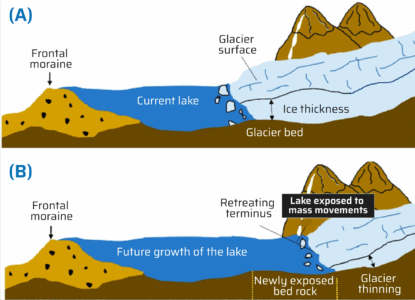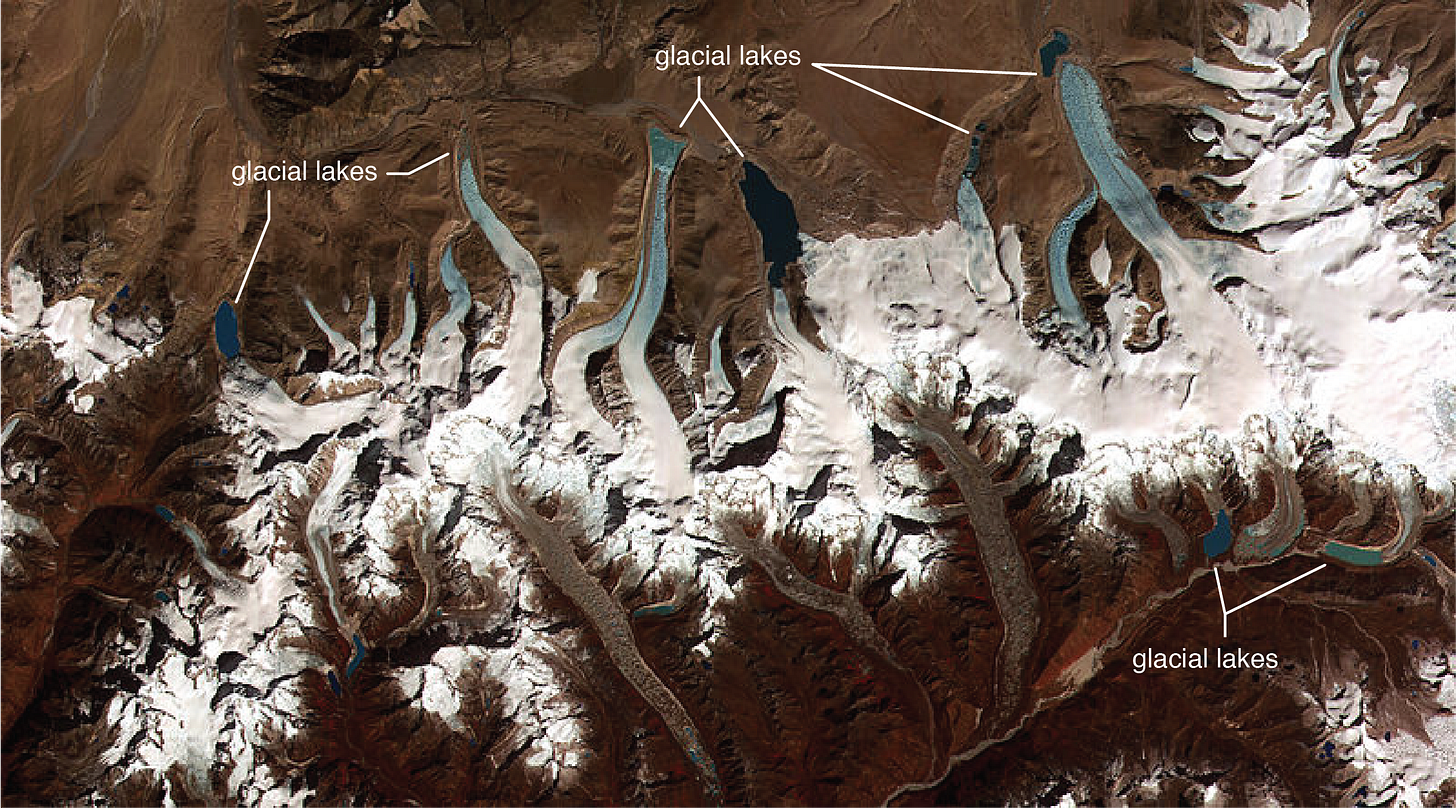#332: Glacial Lake Outburst Flood (GLOF)
Uttarkashi floods analysis are seeing an angle of a Glacial Lake Outburst! Let’s learn a bit about the lesser known event!
A Glacial Lake Outburst Flood (GLOF) is a sudden and catastrophic release of water from a glacial lake due to the failure of natural dams, such as moraines or ice, causing devastating floods downstream.
It is a critical topic for UPSC under Geography, Disaster Management, Environment, and Climate Change (General Studies Paper 1 and 3)
Formation of Glacial Lakes
Glacial Lakes: Bodies of water formed by the melting of glaciers, typically in depressions carved by glacial erosion.
Types:
- Moraine-dammed lakes: Formed by debris (moraine) left by retreating glaciers. These are unstable due to loose sediment.
- Ice-dammed lakes: Formed when glaciers block drainage, holding meltwater. These are prone to failure during glacier retreat or advance.
- Erosion-based lakes: Formed in depressions eroded by glaciers.
- Supraglacial/Subglacial lakes: Form on or beneath glaciers.
- Locations: Commonly found in high-altitude regions like the Himalayas, Andes, Alps, and polar regions.
- Example: South Lhonak Lake (Sikkim), Devtal Glacial Lake (Garhwal Himalaya).
Process:
- Glaciers erode land, creating basins or depressions.
- As glaciers retreat due to warming, meltwater accumulates in these basins, forming lakes.
- Moraine or ice acts as a natural dam, which is often weak and prone to breaching.
Causes of GLOFs
GLOFs are triggered by various factors:
1. Glacial Melting: Rising global temperatures accelerate glacier retreat, increasing lake volume and pressure on dams.
2. Avalanches/Landslides: Ice or rockfalls into the lake displace water, causing overflow or dam failure.
3. Earthquakes: Seismic activity weakens moraine or ice dams, leading to breaches.
4. Heavy Rainfall/Cloudbursts: Excessive water inflow overwhelms dam capacity.
5. Volcanic Activity: In volcanic regions, heat from eruptions melts glaciers, raising lake levels.
6. Moraine Instability: Weak moraine embankments erode or collapse under water pressure.
7. Human Activities: Infrastructure projects (e.g., dams, roads) in mountainous areas increase geological stress, raising GLOF risks.
Characteristics of GLOFs
1. Sudden Release: Rapid discharge of large water volumes, often within hours or days.
2. High Discharge: Downstream river flows increase significantly, causing flash floods.
3. Catastrophic Impact: Severe damage to life, property, infrastructure, and ecosystems.
Impacts of GLOFs
1. Human Impact:
- Loss of lives and injuries.
- Displacement of communities downstream.
- Example: 2013 Kedarnath floods (Uttarakhand) caused ~5,000 deaths due to a GLOF from Chorabari Tal.
2. Infrastructure Damage:
- Destruction of roads, bridges, hydropower projects, and settlements.
- Example: 2023 South Lhonak Lake GLOF (Sikkim) breached the Chungthang Dam, causing widespread damage.
3. Environmental Impact:
- Erosion, sediment deposition, and alteration of river channels.
- Disruption of ecosystems due to high sediment loads.
4. Economic Losses:
- Damage to agriculture, tourism, and infrastructure.
- High recovery and rehabilitation costs.
5. Transboundary Risks:
- GLOFs in the Himalayas affect India, Nepal, Bhutan, and China, as rivers like the Indus, Ganga, and Brahmaputra cross borders.
Key Statistics
- Himalayan Glacial Lakes: ~28,000 glacial lakes in the Indian Himalayan Region (IHR), with ~7,500 in India.
- Expansion: ISRO (2023) reported 676 Himalayan glacial lakes larger than 10 hectares expanded significantly since 1984, with 130 in India (Indus: 65, Brahmaputra: 58, Ganga: 7).
- High-Risk Lakes: 67 lakes in India have increased in size by over 40%, posing a high GLOF risk.
- Population at Risk: Globally, ~15 million people are vulnerable to GLOFs, with 9.3 million in High Mountain Asia.
Major GLOF Events
1. Kedarnath, Uttarakhand (2013): Triggered by Chorabari Tal breach, causing ~5,000 deaths.
2. Chamoli, Uttarakhand (2021): Flash floods linked to a GLOF in the Nanda Devi Glacier region.
3. South Lhonak Lake, Sikkim (2023): Cloudburst and possible earthquake triggered a GLOF, breaching Chungthang Dam, killing over 40 people.
4. Lugge Tsho, Bhutan (1994): Highlighted regional vulnerability to glacial melting.
5. Dig Tsho, Nepal (1985): Caused significant downstream damage.
6. Lake 513, Peru (2010): GLOF due to glacial dam failure.
Mitigation Strategies (NDMA Guidelines)
1. Identification and Mapping:
- Use field observations, historical data, and geotechnical studies to identify vulnerable lakes.
- Example: Sikkim SDMA identified 10 high-risk lakes, including South Lhonak.
2. Monitoring Technologies:
- Use Synthetic-Aperture Radar (SAR) imagery and satellite data to track lake changes.
- ISRO and NESAC monitor lake expansion in the Himalayas.
3. Structural Measures:
- Controlled breaching of lakes to reduce water volume.
- Pumping out water or constructing tunnels through moraine/ice dams.
- Example: In 2016, South Lhonak Lake’s water was siphoned off using HDPE pipes, reducing risk.
4. Land-Use Planning:
- Restrict construction in high-risk zones.
- Relocate infrastructure and settlements from vulnerable areas.
5. Early Warning Systems:
- Develop real-time monitoring and alert systems for downstream communities.
- Conduct evacuation drills and awareness campaigns.
6. Community Engagement:
- Train local populations for search and rescue operations.
- Promote afforestation in catchment areas to reduce flood intensity.
7. Research and Collaboration:
- Encourage studies on glacial dynamics and transboundary cooperation for monitoring.
Challenges in GLOF Mitigation
1. Remote Locations: Glacial lakes in rugged terrains are hard to access for monitoring.
2. Limited Data: Lack of real-time data and expertise in remote areas.
3. Climate Change: Accelerated glacier retreat increases lake formation and GLOF frequency.
4. Complex Terrain: Steep landscapes complicate mitigation and response efforts.
Significance for UPSC
- Geography: Understanding glacial landforms, lake formation, and their role in shaping landscapes.
- Disaster Management: Strategies for risk assessment, mitigation, and response to GLOFs.
- Environment and Climate Change: Impact of global warming on glacier retreat and lake expansion.
- Current Affairs: Recent events (e.g., 2023 Sikkim GLOF) and ISRO/CWC reports on Himalayan lakes.
Key Recommendations
- Strengthen early warning systems and real-time monitoring using satellite technology.
- Promote sustainable infrastructure development in Himalayan regions.
- Enhance international cooperation for transboundary risk management.
- Integrate GLOF risk into urban and regional planning.



